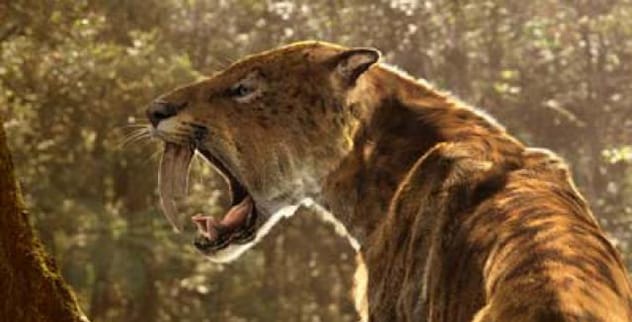Nature has an incredible knack for creating tools perfectly suited for survival. Some of these are truly awe-inspiring in their design. Among the most impressive and fearsome natural weapons are saberteeth. These elongated, razor-sharp canines weren’t just a one-time fluke of evolution; they appeared multiple times in entirely different groups of animals throughout Earth’s history. Get ready to sink your teeth into a list of some of the most fascinating creatures ever to wield this deadly dental hardware!
1. Machaeroides Eothen
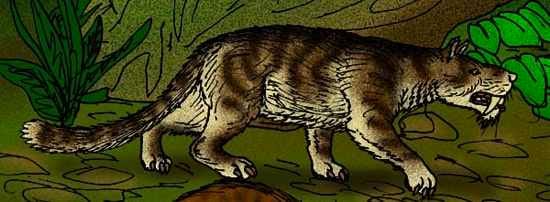
Meet Machaeroides, one of the earliest mammals to sport those impressive saberteeth. Imagine a creature about the size of a large fox or a small coyote. But don’t let its size fool you! Thanks to its enlarged canine teeth, it could likely take down prey much larger than itself.
Machaeroides roamed the Earth during the Eocene period, over 50 million years ago. It belonged to the Creodonta group. These were predatory mammals that ruled the world before modern meat-eaters, the Carnivora (the group today’s meat-eating mammals belong to), came along. It’s important not to mix up Machaeroides with Machairodus. Machairodus was an actual sabertooth cat and a member of the Carnivora order that eventually replaced creodonts like Machaeroides.
2. Uintatheres
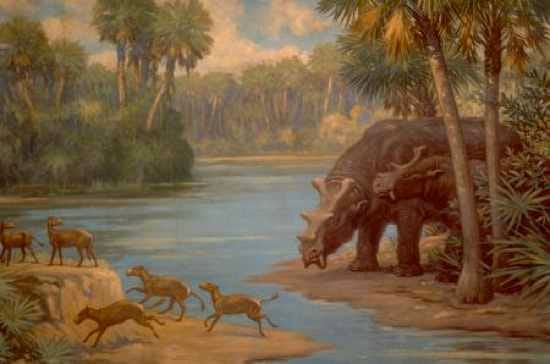
Not all animals with saberteeth were carnivores. Take the Uintatheres, for example. These large, rhinoceros-like beasts lived during the Eocene period and were complete vegetarians. Yet, they possessed a pair of truly monstrous-looking canine teeth.
Interestingly, it seems only male Uintatheres had these saberteeth. This suggests they weren’t used for defense against predators or for eating. Instead, it’s more likely that male Uintatheres used these impressive fangs to fight each other for dominance or the chance to mate. Much like modern hippos, Uintatheres probably had very thick skin and a strong ability to heal to survive these intense duels.
3. Gorgonopsids
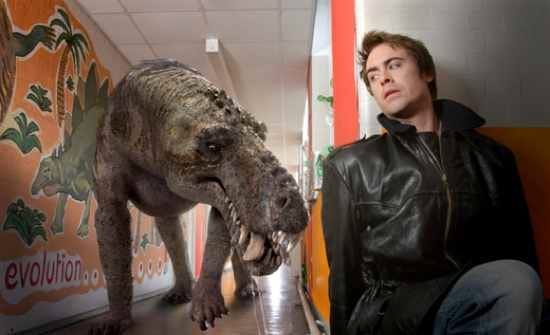
Gorgonopsids might not be household names, but these creatures were fascinating. They had traits common to both mammals and reptiles and are often seen as a kind of “link” between these two groups. They were highly evolved predators, and most of them had saberteeth.
It’s thought that Gorgonopsids developed saberteeth because their prey species were getting larger and developing tougher skin. These creatures varied in size, from as small as a house cat to as long as four to six meters in the largest species like Leontocephalus and Inostrancevia. Some Gorgonopsids even had two pairs of short, dagger-like saberteeth! To use them effectively, Gorgonopsids could open their jaws to a full 90-degree angle. This ability made them arguably the deadliest predators of the Permian period, around 280-250 million years ago.
4. Dinofelis
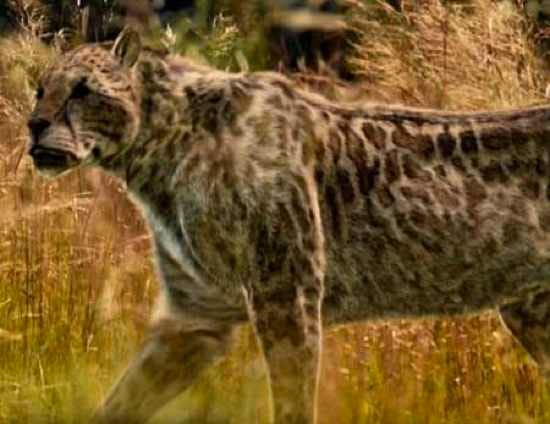
Dinofelis means “terrible cat,” and it’s a fitting name for this feline, which was about the size of a jaguar. It prowled across Africa, Asia, Europe, and North America roughly 5 to 1 million years ago. Armed with short, dagger-like teeth, Dinofelis is one of many true felines that evolved saberteeth.
What makes Dinofelis stand out is that it appeared to be a specialized primate-hunter. Fossils of baboons and other primates are often found in ancient Dinofelis lairs. Some of these fossils even have puncture holes that perfectly match Dinofelis’ saberteeth. Among the primates it hunted were two of our early human relatives, Australopithecus and Paranthropus. This suggests Dinofelis played a scary part in the nightmares of our ancestors. Dinofelis eventually went extinct due to the shrinking of forests, and thus many primate species, at the beginning of the last Ice Age.
5. Barbourofelis
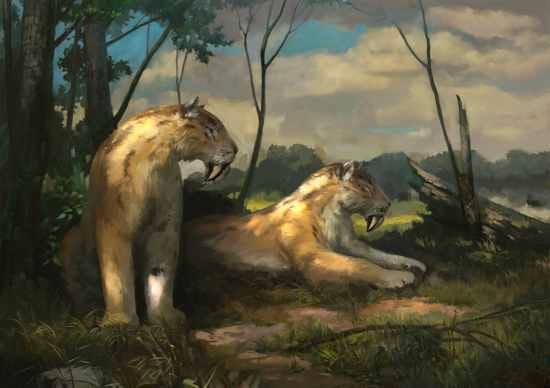
This peculiar beast looked like a mix between a bear and a sabertoothed tiger. However, Barbourofelis was not related to either. It belonged to its own family, Barbourofelidae, and was a top predator in North America during the Miocene period, about 13 to 5 million years ago.
Unlike felines, Barbourofelis was a plantigrade. This means it walked on the entire sole of its foot, similar to bears or humans, rather than on its toes. This made it slower than true sabertooth cats, so Barbourofelis was likely more of an ambush hunter that rarely chased its prey. Its large size (as big as a lion, but much stronger) and plantigrade stance allowed it to stand on its hind feet like a bear. This helped Barbourofelis wrestle large prey to the ground and hold them firmly while delivering a deadly bite with its 23 cm long sabers.
6. Nimravids (Hoplophoneus)
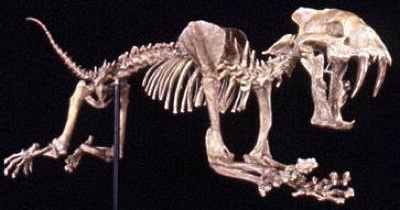
Nimravids were another group of predatory mammals that died out without leaving any descendants. Despite this, they were very successful and numerous from the Eocene to Miocene periods, about 37 to 5 million years ago. They looked a lot like cats but featured saberteeth. Many Nimravids also had strange, scabbard-like flanges on their lower jaws, which protected their long sabers when not in use.
Fossil evidence paints a picture of Nimravids as extremely vicious and dangerous animals. Different species would even kill each other in gruesome fights. For example, a skull of a small species, Nimravus, was found with a hole that matched the saberteeth of Eusmilus, a larger Nimravid from the same time and place. Amazingly, the wound showed signs of partial healing, meaning the Nimravus actually survived the encounter!
7. Smilodon
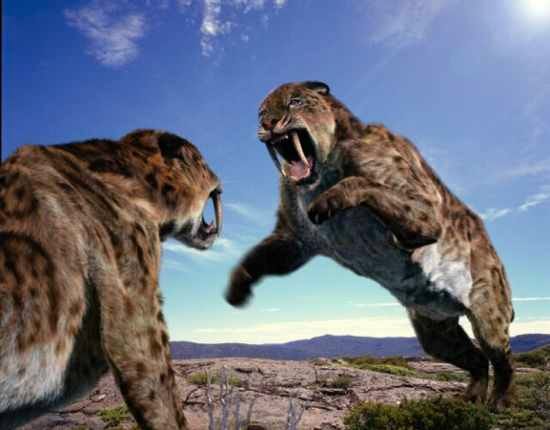
The famous “sabertooth tiger,” Smilodon, was among the largest true sabertoothed cats. Some South American species reached a staggering 500 kgs in weight! What made them even more frightening was that they seemingly hunted in packs (or perhaps “prides”). The largest Smilodon wielded 30 cm long canines and were perfectly adapted to kill large prey. Their menu included everything from bison and horses to mammoths and giant ground sloths.
One bite from a Smilodon was likely enough to cause massive bleeding and shock. If aimed well, it could pierce internal organs or sever major arteries and veins. They also had incredibly strong forelimbs and enormous claws, meaning they could wrestle large animals to the ground more easily than modern lions or tigers. It’s even believed that Smilodon caused the extinction of other predators when it first crossed into South America. The scariest part? Smilodon only went extinct about 10,000 years ago, meaning early modern humans encountered these deadly cats and probably became their prey from time to time.
8. Thylacosmilus
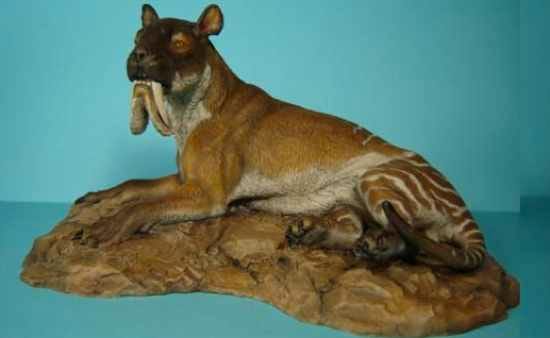
Although it looked a bit like a sabertooth cat, Thylacosmilus was actually a marsupial. This means it was more closely related to koalas and kangaroos than to Smilodon. It was one of the top predators in South America during the Miocene, Pliocene, and early Pleistocene periods. While not as large as Smilodon – being about the size of a modern jaguar – its saberteeth were even more extreme.
The fangs of Smilodon reached their maximum size and then stopped growing once the cat reached adulthood. Thylacosmilus’ sabers, however, kept growing throughout its entire life! They were so long that the roots of the canines arched over its eye sockets, giving the animal a distinctive arched forehead. Because its canines were so long, Thylacosmilus, like the Nimravids mentioned earlier, had scabbard-like flanges on its lower jaw to protect the sabers when they weren’t in use.
Thylacosmilus was slower than Smilodon and likely an ambush hunter. It was undoubtedly a deadly beast, but its long reign ended in the Pleistocene. This was when true felines and other predators arrived in South America, replacing many of the native marsupial meat-eaters. Among these newcomers was Smilodon. Thylacosmilus simply couldn’t compete with its monstrous feline counterpart and went extinct about 2 million years ago.
9. Kaprosuchus
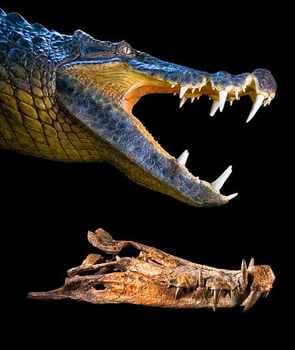
Perhaps the most monstrous-looking of all sabertoothed creatures is the recently discovered Kaprosuchus. This was a very large crocodilian, measuring about six meters long, with not one, but three pairs of saberteeth! One of these pairs was located in the lower jaw. When the crocodile closed its mouth, these teeth protruded like a wild boar’s tusks, earning it the popular nickname “Boar Croc.”
Unlike modern crocodiles, Kaprosuchus seems to have been a fully terrestrial animal. It’s believed to have hunted other large land animals – including dinosaurs. We don’t know if it hunted alone or in packs, as only one skull from this species has been found. Either way, it was certainly a formidable killer, described by some as the equivalent of “a sabertoothed cat in armor.” It lived during the Cretaceous period, 95 million years ago, in what is today the Sahara desert.
10. Burrowing Asp
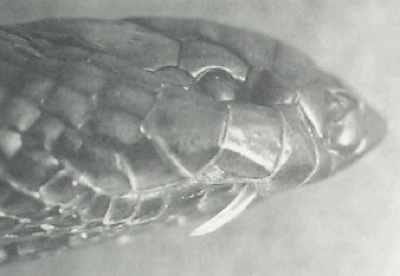
Most sabertoothed animals are now extinct, but there’s still a dangerous predator in our times that uses enlarged fangs to kill its prey. It’s easily the least known and most bizarre of them all: the Burrowing Asp. This is a smallish snake from Africa that spends most of its life underground. It feeds on rodents and has enlarged fangs that essentially function as venomous saberteeth, sticking out of its mouth when in use.
This unique feature means the Burrowing Asp can bite without even opening its mouth! This is very useful as it prevents dirt from getting into the snake’s mouth during a struggle. Unlike the sabers of the other animals on this list, the burrowing asp’s fangs are flexible and can be moved independently of each other. This allows the snake to stab its prey sideways with one fang. Once it has killed its victim, it can use these movable fangs to manipulate the prey’s body for easier swallowing. Burrowing Asp venom is moderately strong. Since the snake can bite with its mouth closed, extra care is needed if handling one. There are known cases of children dying after a Burrowing Asp bite; however, encounters between these snakes and humans are rare because they seldom leave their underground burrows.
11. Clouded Leopard (Bonus)
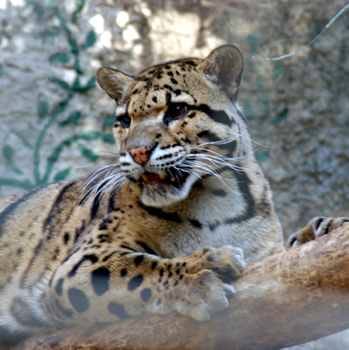
Despite what some people might say, sabertoothed cats like Smilodon or Dinofelis were not the ancestors of any modern-day cat. They all went extinct without leaving any descendants. However, there might be a potential sabertooth ancestor living today! It’s the Clouded Leopard, a medium-sized feline from the rainforests of India and southeastern Asia.
Just like Dinofelis, the Clouded Leopard feeds mostly on primates such as monkeys and apes. It’s known for its beautiful fur pattern and incredible agility. But it’s also remarkable because it has the longest fangs (relative to its body size) of all living cats. This is especially clear when you look at a Clouded Leopard’s skull; its fangs are as long as those of many early sabertooth cat species! Scientists suggest that the Clouded Leopard could be the beginning of a brand new lineage of sabertoothed cats. Of course, this depends on whether this beautiful creature survives long enough, as habitat destruction and poaching are constant threats to the two Clouded Leopard species living today.
The journey through the world of saber-toothed creatures reveals an amazing story of evolution. From ancient mammals and reptile-like beasts to even a modern snake, the development of these formidable fangs shows how nature adapts. While many of these incredible animals are long gone, their fossils tell a tale of power, survival, and the incredible diversity of life on Earth. The legacy of the saber – a truly cutting-edge adaptation!
Which of these saber-toothed animals do you find most fascinating? Did any surprise you? Share your thoughts in the comments below!


